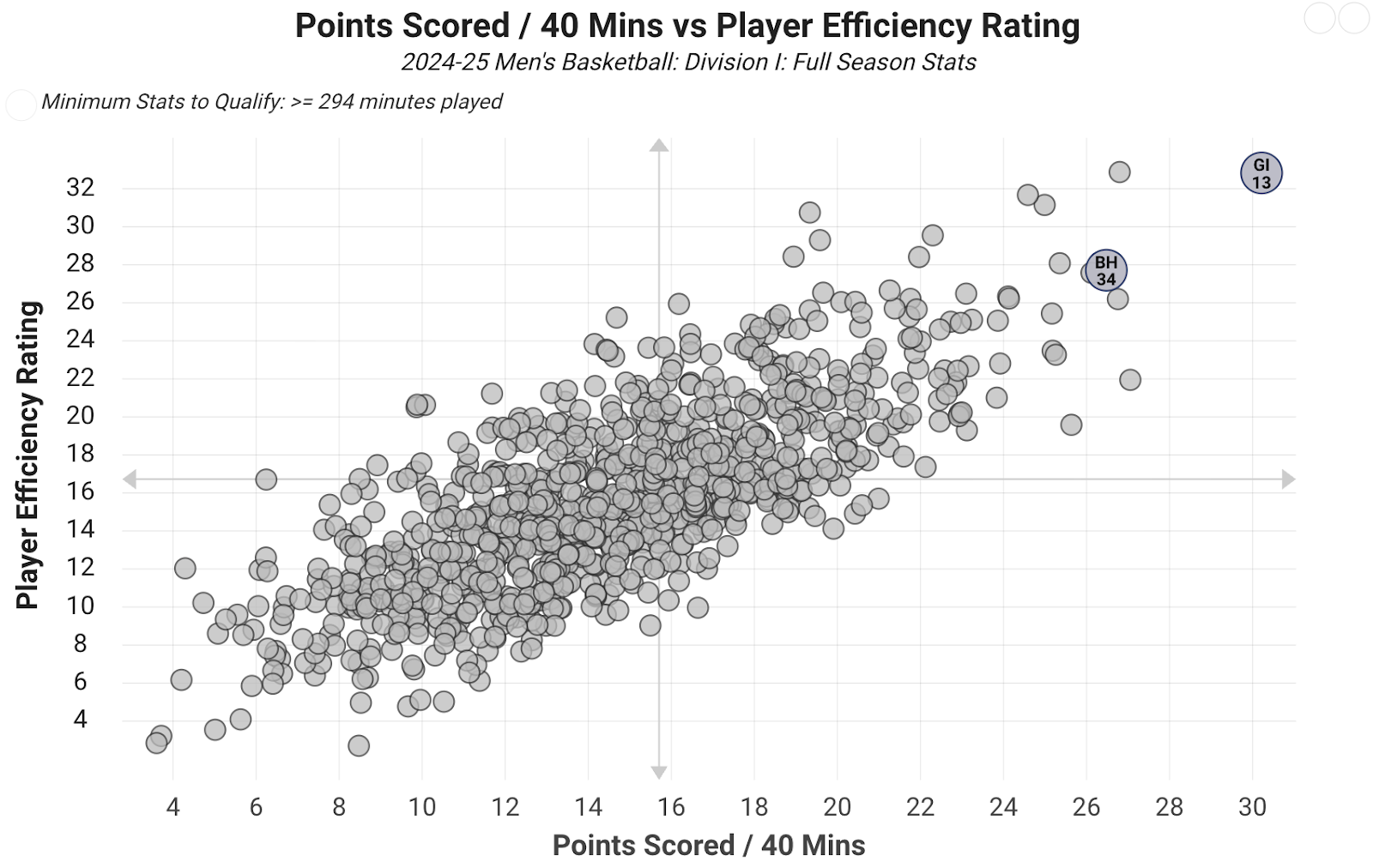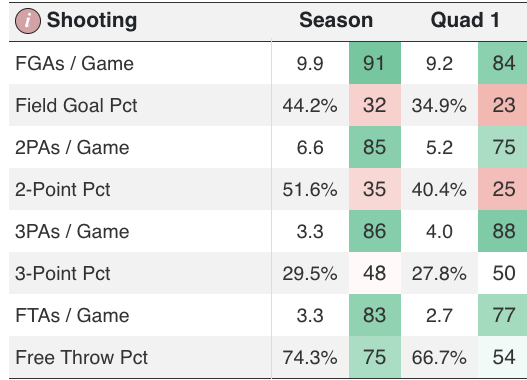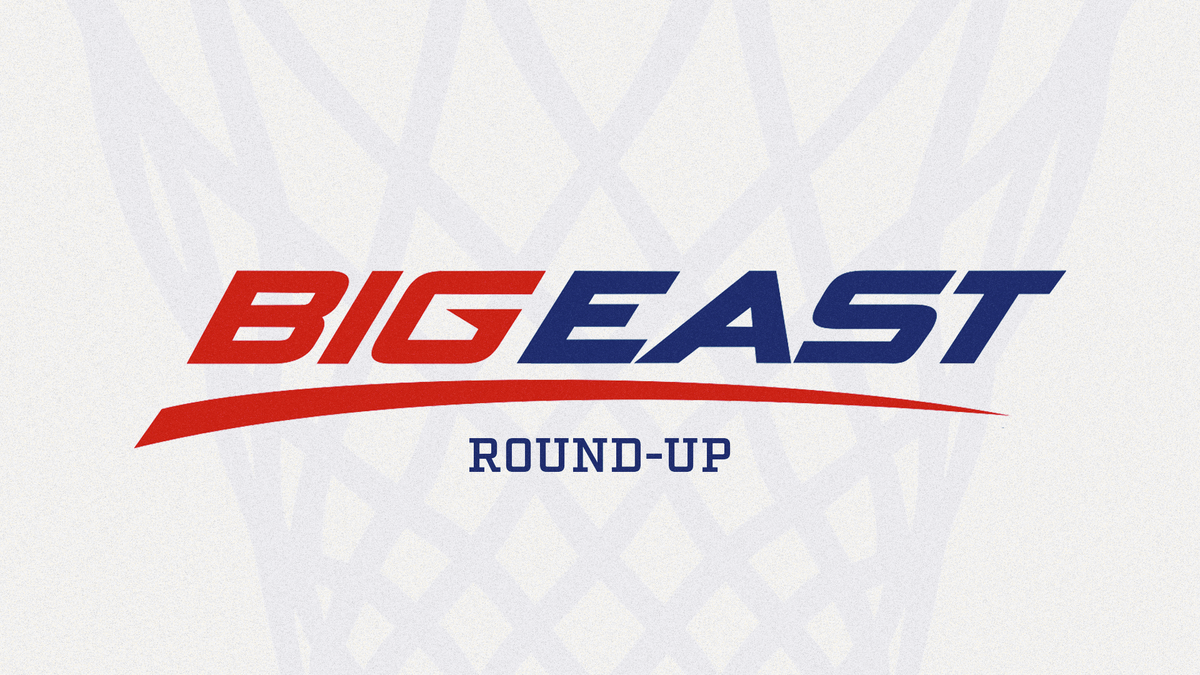As the season kicks off, it's worth taking a look at how we evaluate roster retention and how veteran coaches navigate finding pieces to replace decorated leaders who are now eligible. And as we begin our coverage of West Coast college hoops ahead of the return of the Pac-12, it's worth taking a look at two former WAC schools looking to compete right away in their new digs.
Are we somehow underrating Gonzaga’s post offense again?
October is the month for lists in college basketball media, and it seems like, yet again, an offense that finished in the top 10 in KenPom adjusted offensive efficiency the last eight seasons is not at the front of mind for these power rankers, despite returning two of the most efficient and high usage bigs in the country, senior Graham Ike and junior Braden Huff.

Ike and Huff were in the 100th and 99th percentiles for points per 40 minutes last season. They combined for an effective field goal rate of 60.5%, impressive considering that they took 30% of the team’s total shots. Ike was in the 99th percentile and Huff the 97th percentile for usage.
Both were about as automatic as can be in the paint, shooting 65.6% and scoring nearly 20 points in that area per game. Creighton’s portal acquisition, Owen Freeman, is the loan player in Division I to average more points in the paint per 40 minutes than the two Gonzaga bigs last season.

The two largely played as a tag team, largely due to their penchant for fouling, but finished the season starting together because of lackluster play from the forward position. What makes the tandem work is their willingness to pass (both have an assist rate in the 82nd percentile or better) and attack from different levels of the half-court (Ike on the low block, Huff shooting over his defender from the elbow and high post).
The bigs achieved this level of success despite the worst three-point shooting in the history of Mark Few’s career, shooting just 35.4%, and marking the first time the Zags have finished outside of the top 50 in three-point percentage in five seasons.
The concern over Ryan Nembhard’s departure is understandable, considering his on-ball role and duties as basically the lone creator on last season’s team. But that dependency also made the Bulldogs’ offense predictable and removed the ball movement that made their continuity offense hum in their championship runs. Nembhard accounted for nearly 50% of the team’s assists last season. No player other than the younger Nembhard brother accounted for over 35% of the team’s assists in the last 15 seasons.
Increased ball movement and improved supporting pieces could make this Gonzaga offense even more dangerous.
What to make of St. Mary’s preseason slate
The Gaels received two first-place votes in the WCC Preseason Coaches’ Poll despite the major losses in two-time WCC Player of the Year Augustas Marčiulionis and two-time WCC Defensive Player of the Year Mitchell Saxen graduating and point guard-in-waiting Jordan Ross transferring to Georgia.
Head coach Randy Bennett and his staff have earned that trust by displaying unparalleled consistency at the mid-major since the 2020-2021 season, which began a stretch of five straight seasons as an adjusted defensive efficiency team with fou different trips to the NCAA tournament. But throughout that run the Gaels have had a dependable, integral player to bridge each changing of the guard, and that just isn’t readily apparent in returning starters Mikey Lewis and Paulius Murauskus.
Because of the loss of Marčiulionis and Ross, backcourt roles and minutes appeared murky heading into their exhibition games against Arizona and Ole Miss, two teams with real March expectations. Lewis is a clear undersized shooting guard built to score off-ball or to create his own shot, not really adept in creating for others. The Gaels poached former San Diego guard Tony Duckett, but he, too, is more of a scorer than a facilitator.
The aforementioned trust in Bennett is warranted because of his ability to find replacement pieces internally and integrate them into effective weapons. This program transformed Tommy Kuhse, a walk-on, into an all-conference team member by his senior season. And if anything became clear early on, the staff thinks sophomore Aussie Joshua Dent can pop in a similar way.
Dent started and led the team in scoring in their 68-81 loss to Arizona, scoring 14 points, adding 2 assists and notably 5 turnovers. In the exhibition wing against Ole Mississippi, he recorded 7 points and 8 assists. Dent with time could develop into a solid facilitator, but these preseason games have proven that so much of the Gaels’ hopes lie on shot making from Murauskus and Lewis, who looked completely different against the Wildcats and Rebels.
Lewis was subdued by Arizona’s group of defensive guards and shot 4 for 15 in Tucson, but against Mississippi, he scored 20 points with 13 coming in the first half. The results matched Lewis’ up-and-down freshman season and its streakiness, something the Gaels can’t afford now that he’s shifted into major minutes and usage.
Marauskus also had opposing results in these matchups, going 4 for 10 against Arizona and the game’s leading scorer with 21 points in the trip to Oxford. Marauskus struggled last season when facing higher competition; his field goal percentage dropped from his season average of 44% to 34% when playing Quad 1 teams.

In positive news, replacing Saxen doesn’t appear to be the hurdle that it may have first seemed with the breakout of redshirt sophomore Andrew McKeever early on. The 7-foot-2 big man received starts over senior Harry Wessels in both dress rehearsals, a bit of surprise considering Wessels' impactful minutes as the backup last season.
McKeever is a load and extremely difficult to keep away from rebounds, recording 10 of them against Arizona and 6 boards and 2 blocks against Mississippi. The supporting pieces appear to be in place again for the Gaels; it's about finding that dependability from two players of high pedigree and expectations, as both are preseason all-conference team members.
Former WAC schools jumping up a level in Seattle and Grand Canyon
With the Pac-12’s return a year away, the WCC and MWC needed to find new teams to replace the eight schools leaving after the season. In comes Seattle University and Grand Canyon, two schools that finished in the top 4 in the WAC the last two seasons. Both schools have demonstrated the ability to compete with higher-level mid-majors and adapt to the changing landscape of college basketball.
“One of the things would be we have to learn a whole new conference and opponents,” head coach Chris Victor said. “But a big thing is that the WCC has proven with the level of competition that size is a big difference from where we’ve been to where we’re going. One of the things needed to sustain throughout conference [play] is to get bigger through [the roster].”
Heading into the WCC, Victor prioritized recruiting portal players over high school recruits, hoping they could have an immediate impact against a more formidable group of conference opponents. The added size will come from forwards Junseok Yeo, who showed athleticism to pair with his 6-foot-8 frame but could never really break into the Zags’ rotation, and Brock Felder, who averaged 5.8 points and 6.2 rebounds with Southern Utah last season.
Seattle made sure to add impact scorers from the junior college level with Jojo Murphy and Milos Amos joining an experience-heavy backcourt featuring seniors Maleek Arrington, John Christofilis and Brayden Maldonado. As much as size was a priority in the portal, improving the scoring to compete with a more offensive-minded conference was also a necessity.
“The style of play from the WAC to the WCC is very different,” Victor said. “How quickly we adapt and learn from our opponents is going to be a big part of it, too.”
Bryce Drew’s Grand Canyon finds themselves in a similar situation playing in the Mountain West the last season five schools dip to the Conference of Champions. While the MWC has been at a higher analytical level than the WCC, the physicality of the league is more aligned with the WAC and the style of play the Antelopes have had to go up against.
The investment in the program certainly helps the transition and in adding quality pieces in the portal in wings Jaden Henley and Dusty Stromer, guard Brian Moore and bigs Nana Owusu-Anane and Wilhelm Breidenbach. These additions point to a concerted effort by Drew and his staff to improve their defense and ability to win on the glass, two points of emphasis in their new conference.
The rebounding and defense have been evident in their two exhibition games against power conference matchups. Owusu-Anane recorded 16 and 8 rebounds respectively in the warm-up matchups against USC and Baylor, where he played a notable 34 minutes per game. Cause for concern, however, is his lack of shotmaking, going 5 for 24 over the exhibitions.
Even more concerning for Grand Canyon is the lack of a sure answer for who to pair with Owusu-Anane in the frontcourt. Breidenbach, Efe Demirel and Dennis Evans combined for just 10 rebounds over those two exhibition games. If Owusu-Anane can’t get his scoring together or stay on the floor, there aren’t many clear answers available to Drew’s staff on the team.


